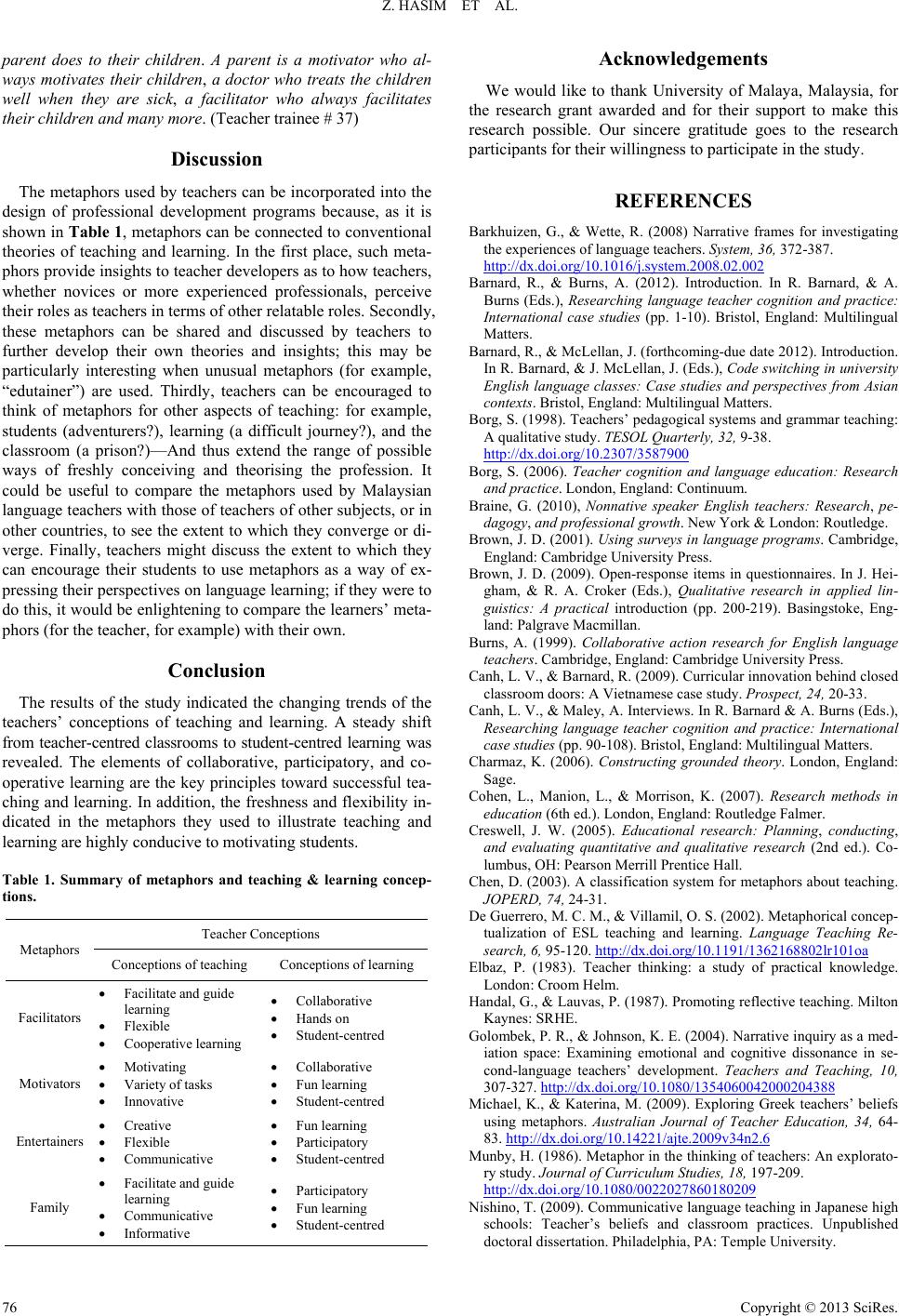
Z. HASIM ET AL.
Copyright © 2013 SciRes.
parent does to their children. A parent is a motivator who al-
ways motivates their children, a doctor who treats the children
well when they are sick, a facilitator who always facilitates
their children and many more. (Teacher trainee # 37)
Discussion
The metaphors used by teachers can be incorporated into the
design of professional development programs because, as it is
shown in Table 1, metaphors can be connected to conventional
theories of teaching and learning. In the first place, such meta-
phors provide insights to teacher developers as to how teachers,
whether novices or more experienced professionals, perceive
their roles as teachers in terms of other relatable roles. Secondly,
these metaphors can be shared and discussed by teachers to
further develop their own theories and insights; this may be
particularly interesting when unusual metaphors (for example,
“edutainer”) are used. Thirdly, teachers can be encouraged to
think of metaphors for other aspects of teaching: for example,
students (adventurers?), learning (a difficult journey?), and the
classroom (a prison?)—And thus extend the range of possible
ways of freshly conceiving and theorising the profession. It
could be useful to compare the metaphors used by Malaysian
language teachers with those of teachers of other subjects, or in
other countries, to see the extent to which they converge or di-
verge. Finally, teachers might discuss the extent to which they
can encourage their students to use metaphors as a way of ex-
pressing their perspectives on language learning; if they were to
do this, it would be enlightening to compare the learners’ meta-
phors (for the teacher, for example) with their own.
Conclusion
The results of the study indicated the changing trends of the
teachers’ conceptions of teaching and learning. A steady shift
from teacher-centred classrooms to student-centred learning was
revealed. The elements of collaborative, participatory, and co-
operative learning are the key principles toward successful tea-
ching and learning. In addition, the freshness and flexibility in-
dicated in the metaphors they used to illustrate teaching and
learning are highly conducive to motivating students.
Table 1. Summary of metaphors and teaching & learning concep-
tions.
Metaphors Teacher Conceptions
Conceptions of teaching Conceptions of learning
Facilitators
• Facilitate and guide
learnin g
• Flexible
• Cooperative learning
• Collaborative
• Hands on
• Student-centred
Motivators
• Motivating
• Variety of tasks
• Innovative
• Collaborative
• Fun learning
• Student-centred
Entertai ner s
• Creative
• Flexible
• Communicative
• Fun learning
• Particip ator y
• Student-centred
Family
• Facilitate and guide
learnin g
• Communicative
• Informative
• Particip ator y
• Fun learning
• Student-centred
Acknowledgements
We would like to thank University of Malaya, Malaysia, for
the research grant awarded and for their support to make this
research possible. Our sincere gratitude goes to the research
participants for their willingness to participate in the study.
REFERENCES
Barkhuizen, G., & Wette, R. (2008) Narrative frames for investigating
the experiences of language teachers. System, 36, 372-387.
http://dx.doi.org/10.1016/j.system.2008.02.002
Barnard, R., & Burns, A. (2012). Introduction. In R. Barnard, & A.
Burns (Eds.), Researching language teacher cognition and practice:
International case studies (pp. 1-10). Bristol, England: Multilingual
Matters.
Barnard, R., & McLellan , J. (forthcoming-due date 2012). Introduction.
In R. Barnard, & J . McLellan, J. (Eds.), Code switching in univer sity
English language classes: Case studies and perspectives from Asian
contexts. Bristol, England: Multilingual Matters.
Borg, S. (199 8). Tea chers’ pedagogical s ystems and gra mmar teaching:
A qualitative study. TESOL Quarterly, 32, 9-38.
http://dx.doi.org/10.2307/3587900
Borg, S. (2006). Teacher cognition and language education: Research
and practice. London, England: Cont inuum.
Braine, G. (2010), Nonnative speaker English teachers: Research, pe-
dagogy, and professional growth. N ew York & London: Routledge.
Brown, J. D. (2 001). Using surveys in language programs. Cambridge,
England: Cambridge University Press.
Brown, J. D. (2009). Open-response items in questionnaires. In J. Hei-
gham, & R. A. Croker (Eds.), Qualitative research in applied lin-
guistics: A practical introduction (pp. 200-219). Basingstoke, Eng-
land: Palgrave Macmillan.
Burns, A. (1999). Collaborative action research for English language
teachers. Cambridge, England: Cambridge University Press.
Canh, L. V., & Barnard, R. (2009). Curricular innovation behind closed
classroom doors: A Vietnamese case study. Prospect, 24, 20-33.
Canh, L. V., & Maley, A. Interview s. In R. Ba rnard & A . Burns (Eds .),
Researching language teacher cognition and practice: International
case studies (pp. 90-108). Bristol, England: Multilingual Matters.
Charmaz, K. (2006). Constructing grounded theory. London, England:
Sage.
Cohen, L., Manion, L., & Morrison, K. (2007). Research methods in
education (6th ed.). London, England: Routledge Falmer.
Creswell, J. W. (2005). Educational research: Planning, conducting,
and evaluating quantitative and qualitative research (2nd ed.). Co-
lumbus, OH: Pearson Merrill Prentice Hall.
Chen, D. (2003). A classification syste m for metaphors about teaching.
JOPERD, 74, 24-31.
De Guerrero, M. C. M., & Villa mil, O. S . (20 0 2). Meta ph o rical con cep-
tualization of ESL teaching and learning. Language Teaching Re-
search, 6, 95-120. http://dx.doi.org/10.1191/1362168802lr101oa
Elbaz, P. (1983). Teacher thinking: a study of practical knowledge.
London: Croom Helm.
Handal, G., & Lauvas, P. (1987). Promoting r eflective teaching . Milton
Kaynes: SRHE.
Golombek, P. R., & Johnson, K. E. (2004). Narrative i nquiry as a med-
iation space: Examining emotional and cognitive dissonance in se-
cond-language teachers’ development. Teachers and Teaching, 10,
307-327. http://dx.doi.org/10.1080/1354060042000204388
Michael, K., & Katerina, M. (2009). Exploring Greek t eachers’ beliefs
using metaphors. Australian Journal of Teacher Education, 34, 64-
83. http://dx.doi.org/10.14221/ajte.2009v34n2.6
Munby, H. (1986). Metaphor in the thinking of teachers: An explorato-
ry study. J our nal of Curriculum Studies, 18, 197-209.
http://dx.doi.org/10.1080/0022027860180209
Nishino, T. (2009). Co mmunicative lan guage teachin g in Japanes e high
schools: Teacher’s beliefs and classroom practices. Unpublished
doctoral dissertation. Philadelphia, PA: Temple University.